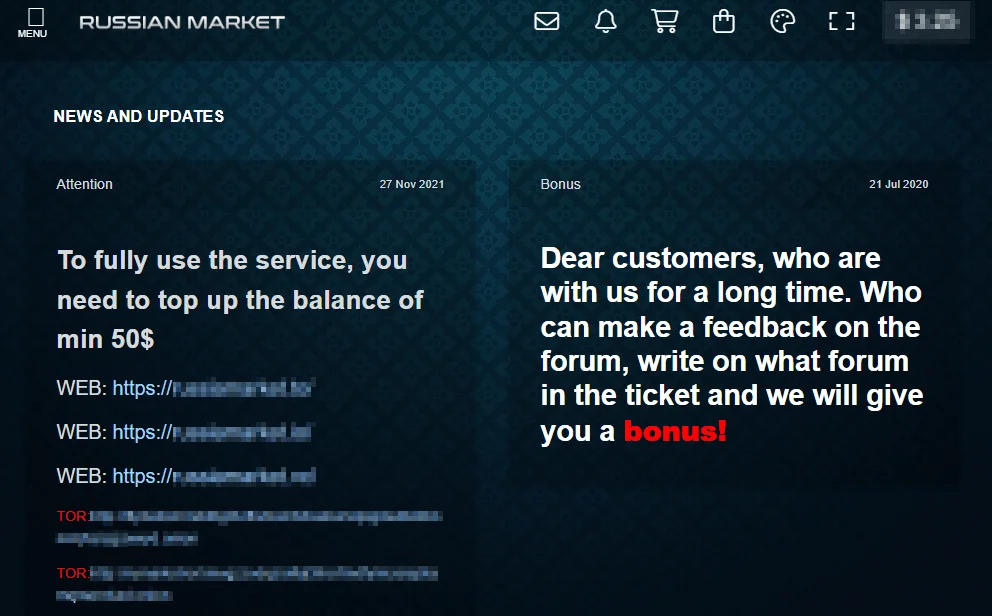Don’t Let Cybercriminals Turn You Into a Bestseller.
Enter your email below to scan for any breaches or leaks on the dark web instantly.
It doesn’t take a sophisticated hacker to buy access to someone’s email, bank account, or corporate login anymore. On the Russian Market, a dark web marketplace, credentials stolen by malware are listed for sale like items on an online shop. With a few clicks and some cryptocurrency, attackers can get their hands on everything from Netflix logins to privileged enterprise accounts.
What makes the Russian Market so dangerous isn’t just the volume of stolen data, but how easy it is to use. Fueled by the rise of infostealer malware like RedLine and Raccoon, this marketplace has become a key player in the global trade of stolen digital identities.
In this article, we break down how it works, what’s being sold, and why organizations need to start taking it seriously.
What Is the Russian Market?
Russian Market (also known as Russian Markat) is a dark web marketplace that emerged in 2019, specializing in the sale of stolen digital credentials such as usernames, passwords, session tokens, browser fingerprints, and other Personally Identifiable Information (PII). It has gained significant traction due to its focus on high-quality stolen data and its streamlined, user-friendly interface.
Much of the data sold on Russian Market is harvested through infostealer malware, making it a major hub for cybercriminals seeking to exploit compromised logins and financial information.
Unlike some underground markets that operate on a limited invite-only basis, the Russian Market is relatively open. It’s accessible via the Tor network, requires only basic registration, and accepts cryptocurrency as payment, typically Bitcoin or Monero. Its interface is simple, searchable, and designed for volume, allowing cybercriminals to browse and filter millions of logs with ease.
How the Russian Market Works
At its core, the Russian Market functions like an online storefront, except what’s being sold isn’t merchandise, it’s access to stolen identities. Sellers upload logs collected from infostealer malware like RedLine or Raccoon, which contain usernames, passwords, cookies, and system data from infected devices. These logs are indexed, priced, and made searchable for buyers.
Buyers can browse through the marketplace using filters like domain name, platform (Google, PayPal, Steam, etc.), or country. Once a log is purchased, the buyer receives a downloadable bundle that may include credentials, browser fingerprints, IP addresses, and even autofill information. Some listings even include built-in “checkers” to verify whether a login still works before purchase.
What’s Sold on the Russian Marketplace
The Russian Marketplace offers a wide range of stolen digital assets, most of which come from infected devices via infostealer malware. The most common items for sale are stealer logs—bundles containing usernames, passwords, cookies, browser fingerprints, and system metadata. These logs are often sorted by platform, making it easy for buyers to target services like Gmail, PayPal, Steam, Facebook, and banking portals.

Beyond basic login details, the Russian Marketplace on dark web also trades in session tokens and cookies that can be used to bypass multi-factor authentication. Listings often include autofill data like names, addresses, phone numbers, and even saved credit card info.
Some vendors go a step further and sell Remote Desktop Protocol (RDP) access, giving buyers direct control over compromised machines.
How Infostealers Feed the Market
Tools like RedLine, Raccoon, Vidar, and Lumma silently infect devices and extract valuable information. Once installed, these programs scan the victim’s browser and system for stored passwords, cookies, autofill data, browser fingerprints, and technical metadata.
Everything they collect is bundled into a file (known as a stealer log) and sent back to the attacker’s command-and-control server.
These infostealers are often spread through phishing emails, malicious ads (malvertising), cracked software downloads, or bundled in fake installers. In many cases, victims don’t even realize they’ve been infected as there’s no ransomware message, no pop-up, just a silent siphoning of their most sensitive data.
Once enough logs are collected, attackers either sell them directly or upload them to marketplaces like the Russian Market. There, the logs are indexed by platform and region, making it easy for buyers to search for specific targets.
The process is fast, scalable, and fully automated, turning everyday infections into commodities on the dark web. The Russian Market wouldn’t exist without infostealer malware.
Russian Market’s Role in Credential-Based Attacks
Although no single data breach has yet been publicly linked to the Dark web’s Russian Marketplace, security researchers widely agree that the marketplace plays a major role in enabling credential-based attacks.
The logs sold on the dark web marketplace are frequently used in credential stuffing campaigns, where attackers automate login attempts using stolen usernames and passwords across hundreds of sites.
Because password reuse is so common, even a seemingly low-value log can grant access to sensitive accounts elsewhere. Beyond stuffing, these credentials are used for account takeovers, especially when paired with browser fingerprints or session cookies.
Logs that contain valid session tokens allow attackers to bypass multi-factor authentication and hijack accounts without ever needing a password.
The scale of the Russian Market only amplifies the risk. Tens of thousands of fresh logs are uploaded every week, keeping the inventory current and attractive to cybercriminals.
A study by Secureworks highlighted a 670% increase in Russian Market activity following the takedown of Genesis Market, one of its major competitors. Russian Market quickly filled the vacuum, becoming one of the top destinations for infostealer logs.
Similarly, according to a report from ReliaQuest, the Russian Market listed credentials tied to over 136,000 customer domains and was used by attackers across multiple industries, including finance, healthcare, and government.
Their research confirmed that 77% of logs contained single sign-on (SSO) tokens, and 61% included SaaS credentials, both highly valuable to attackers.
Protecting Against Russian Market–Linked Threats
Stopping infostealers before they exfiltrate sensitive data is critical, but equally important is limiting the damage when logs inevitably surface on marketplaces like the Russian Market. These measures can help reduce your exposure and improve response time:
Strengthen Credential Hygiene
Encourage employees and users to use strong, unique passwords across all platforms. Most stealer logs are valuable because of credential reuse, an attacker with one password can often access multiple services. Enforce password rotation policies, implement checks against reused or compromised credentials, and promote the use of password managers organization-wide.
Deploy Multi-Factor Authentication
While MFA can prevent most unauthorized logins, it’s not always enough. Infostealer logs often contain valid session tokens, letting attackers bypass MFA entirely. Use adaptive MFA that reauthenticates based on device or location risk, and monitor for anomalous behavior like logins from unusual IPs or rapid access across services.
Monitor for Exposed Credentials
Use threat intelligence platforms, dark web monitoring, and breach alert services to detect when your credentials show up in stealer logs. Listings on the Russian Market can be searched by domain, so attackers often target specific organizations.
Early detection enables fast password resets and gives your security team time to investigate and contain potential access.
Detect and Block Infostealers at the Endpoint
Modern infostealers are stealthy, fast, and lightweight, often avoiding detection by traditional antivirus tools. Use EDR (endpoint detection and response) platforms to flag suspicious behaviors like browser data access, unauthorized network requests, or credential dumping.
Block common delivery paths like phishing attachments, fake installers, and malvertising sites.
Invalidate Tokens and Sessions Quickly
One of the biggest risks in stealer logs is the presence of active session tokens. Attackers can use these to log in without passwords or triggering MFA. If you detect credential exposure, force logout across devices, rotate session keys, and expire browser cookies. This shuts down one of the most effective entry points attackers rely on.
Treat Infected Machines as High-Risk Assets
If you confirm that a user’s data was part of a stealer log listed on the Russian Market, treat the device as compromised. Isolate it from your network immediately, perform a full forensic analysis, and reimage if needed. Logs may contain more than just credentials, they could expose sensitive documents, API keys, or SSH credentials stored locally.
Final Word
The Russian Market may feel distant and abstract, but the threats it enables are very real. From stolen logins to full account takeovers, the fallout from infostealer logs can spread fast and wide. Staying ahead means assuming compromise is possible, and preparing like it’s inevitable.








